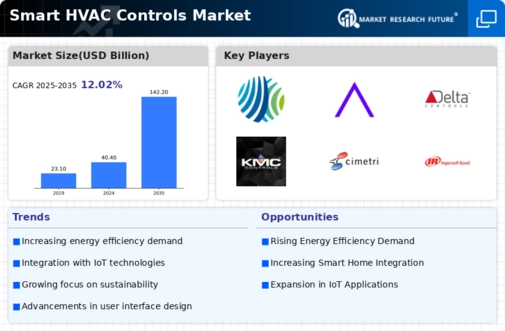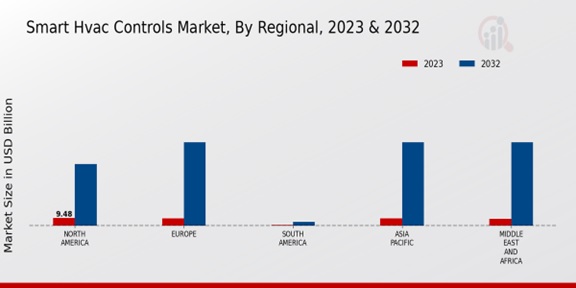Market Growth Projections
The Global Smart HVAC Controls Market Industry is projected to experience remarkable growth in the coming years. With a market value anticipated to reach 40.4 USD Billion in 2024 and further escalate to 142.2 USD Billion by 2035, the industry is on a trajectory of substantial expansion. The compound annual growth rate (CAGR) of 12.12% from 2025 to 2035 underscores the increasing adoption of smart HVAC technologies across various sectors. This growth is driven by a combination of factors, including technological advancements, regulatory support, and rising consumer awareness regarding energy efficiency and indoor air quality.
Technological Advancements in IoT
Technological advancements in the Internet of Things (IoT) significantly influence the Global Smart HVAC Controls Market Industry. The integration of IoT technologies allows for enhanced connectivity and control over HVAC systems, enabling users to monitor and manage their systems remotely. This capability not only improves user convenience but also optimizes energy usage, leading to cost savings. As IoT adoption continues to expand, the market is projected to grow at a compound annual growth rate (CAGR) of 12.12% from 2025 to 2035, indicating a robust future for smart HVAC solutions.
Growing Demand for Energy Efficiency
The Global Smart HVAC Controls Market Industry experiences a surge in demand for energy-efficient solutions as consumers and businesses seek to reduce operational costs and environmental impact. With energy consumption accounting for a substantial portion of global greenhouse gas emissions, smart HVAC systems offer advanced features such as real-time monitoring and automated adjustments. This trend is reflected in the projected market value, which is expected to reach 40.4 USD Billion in 2024. As energy efficiency regulations tighten globally, the adoption of smart HVAC controls is likely to accelerate, driving further growth in this sector.
Government Incentives and Regulations
Government incentives and regulations play a pivotal role in shaping the Global Smart HVAC Controls Market Industry. Many governments worldwide are implementing policies that promote energy-efficient technologies, including smart HVAC systems. These initiatives often include tax credits, rebates, and grants aimed at encouraging the adoption of advanced HVAC solutions. As regulatory frameworks evolve to support sustainability goals, the market is poised for significant growth, with projections indicating a market value of 142.2 USD Billion by 2035. Such incentives not only stimulate demand but also foster innovation within the industry.
Increased Focus on Indoor Air Quality
The Global Smart HVAC Controls Market Industry is increasingly driven by a heightened focus on indoor air quality (IAQ). As awareness of the health impacts of poor air quality rises, consumers and organizations are prioritizing HVAC systems that can effectively filter and circulate air. Smart HVAC controls facilitate real-time monitoring of air quality metrics, allowing for timely adjustments to maintain optimal conditions. This trend is expected to contribute to the market's growth, as systems that enhance IAQ become more sought after, aligning with the broader public health objectives.
Rising Urbanization and Infrastructure Development
Rising urbanization and infrastructure development are key drivers of the Global Smart HVAC Controls Market Industry. As urban areas expand, the demand for efficient and reliable HVAC systems grows, particularly in commercial and residential buildings. Smart HVAC controls offer solutions that cater to the complexities of modern infrastructure, providing enhanced energy management and user comfort. This trend is likely to continue, with the market expected to witness substantial growth as urban centers invest in smart technologies to improve living conditions and reduce energy consumption.




















Leave a Comment